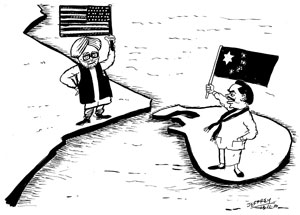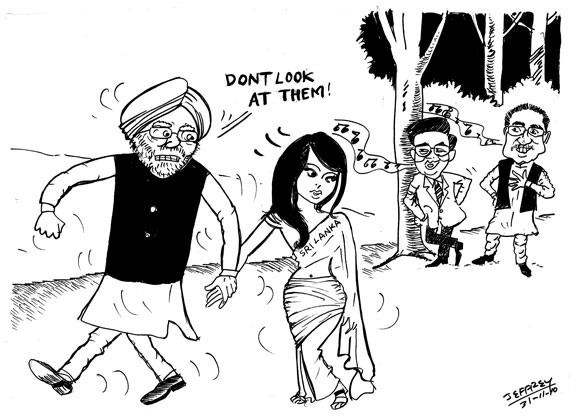 |
However it is missing the point to see China as the ‘problem’ here; it is Sri Lanka’s conduct that should worry India. If Sri Lanka was not to entertain powers hostile to India, then neither China, Pakistan nor any other state can pose a threat via the island.
From the outset
Intrusion into any power’s ‘sphere of influence’ is impossible unless regional states cooperate. Major powers may have unwelcome ambitions in each other’s spheres, but they need willing partners if these are to advance.
In this sense, Sri Lanka's post-independence history shows Colombo has consistently allied - overtly or covertly - with states India has problematic relations with.
Initially - soon after independence - Sri Lanka followed India's lead in foreign policy matters, for example even demanding that the British vacate their naval base at Trincomalee and their air base at Katunayake in 1957.
However, since the late sixties Colombo has consistently reached out to or welcomed extra-regional powers recognised as worrying, or hostile, to India. These have included Pakistan, the US (during the Cold War) and China.
Few state rivalries have been as enduring as India and Pakistan’s - they have fought three wars (1948, 1965 and 1971) and had another serious clash in 1999 (Kargil).
During decades of armed Indo-Pak rivalry, rather than being neutral, Sri Lanka provided direct assistance to Pakistan. During the 1971 war, for example, Pakistani warplanes refuelled in Sri Lanka as they rushed troops (three divisions), arms and supplies to East Pakistan (now Bangladesh).
Since then, despite India’s repeated counter-offers, Pakistan and Sri Lanka have long had close military and other relations – underlined again last week with President Asif Ali Zardari’s visit during which more ties were put in place.
Going West
In 1979, in what was internationally understood as a challenge to India, which had been ‘leaning’ towards Russia rather than Western powers, Sri Lanka blatantly moved to ally with the West in the Cold War ‘struggle’. (See US former Ambassador Jeffrey Lunstead’s comments on p12 here)
However, notably India was insisting on a ‘Non-Aligned’ stance amid the Cold War – the overarching framework of international politics then.
President J. R. Jayawardene strengthened economic, political and military ties with Ronald Reagan’s administration in Washington. These, including the plans for a Voice of America (VoA) station on the island – and the possibility of electronic eavesdropping on India - alarmed Delhi.
These concerns spurred India to first back the Tamil armed struggle against Colombo and, ultimately, to intervene militarily – first in a show of force dropping supplies to the besieged Jaffna population from fighter-escorted supply planes, and then through the Indian Peace Keeping Force (IPKF).
The dramatic changes to international affairs resulting from the end of the Cold War may have dulled US-India tensions, but – until very recently - they have never been put aside. In 2002, for example, the US listed India, China and Russia as potential ‘great power competitors (see p12 here).
Enter the dragon
China and India have had tense relations from the outset. But Sri Lanka’s governments began developing a relationship with China from as early as the fifties.
Sri Lanka has had 119 agreements over the years with China alone.
A striking example is the Rubber- Rice Agreement of 1952, which has been renewed from time to time. The agreement was said to be “too attractive” for Sri Lanka to pass up as it not only provided a market for Colombo’s surplus rubber, but gave access to low priced food-grains.
Yet another early plank of China and Sri Lanka’s relationship was the Maritime Agreements of July 1963 which provided ‘most favoured nation’ treatment for the contracting parties’ commercial vessels moving cargo and passengers between them, and third countries.
China and India had fought their one and only war just months earlier.
The autarkic SLFP government of Prime Minister Srimavo Bandaranaike not only installed today’s Sinhala-first constitution (1972), it also strengthened links China (see how Beijing remembers that era here).
So close were these that the West enthusiastically embraced Junius Jayawardene’s capitalist – and equally Sinhala nationalist - UNP government when it replaced hers and switched allegiances to the West in 1978.
Special relationship
However, President Mahinda Rajapaksa has, despite China being India’s primary great power rival, taken Colombo’s relations with Beijing to a new level. For example, Rajapaksa has visited China five times since becoming President - and three times before assuming Office.
Indeed, this relationship is the most written about today when it comes to Sri Lanka’s international affairs. (See a detailed discussion here.)
These look at China’s funding of massive infrastructure projects (the Hambantota port, for example), other financial and political support, the growing number of Chinese nationals in the country and so on.
Then there are the growing military links. Not only is China the primary supplier of arms (along with Pakistan) to Sri Lanka, the latter’s senior officers are now also going to China for training (formerly they went mainly to UK, US and India).
 |
 |
| Two cartoons published in The Island Dec 1, 2010 |
In response to these ‘Chinese moves’ in Sri Lanka, some Indian analysts are calling on their government to ‘woo back’ Colombo with other incentives.
The Sinhala state is also eagerly promoting this logic – that its dalliance with China turns on Beijing offering Colombo more than Delhi.
Underlying tendency
However, this is to ignore Sri Lanka’s historic tendency to seek out and strengthen links with powers unfriendly, or hostile, to India at any given time.
Any power’s ‘sphere of influence’ rests not on outbidding external powers for regional states’ loyalties, but the latter accepting its pre-eminence and benignly pursuing their own interest in this context. Consider the US and Central American states, or Russia and those states Moscow deems in its ‘near abroad’.
Indeed, if perpetual rivalry is to be assumed, it is the conduct of the regional state that makes possible threats to a power, not that of the rival. For example, when Georgia began edging towards joining NATO, Russia took action against Georgia, not against the alliance.
What is important here is not whether China poses a threat to India or not, but, if this is the case – as many analysts feel – why Sri Lanka is – still - aggressively pursuing a strategic relationship with Beijing (and Pakistan) while keeping India at arm’s length.
